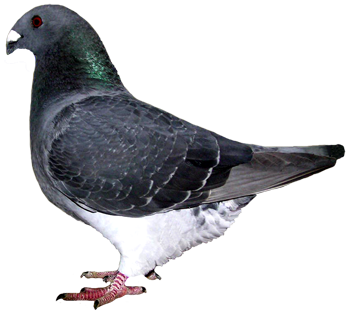
9. X-Pigeons |
||||
CT - T-pattern
 There
are four main pigeon patterns: Barless
(c), Bar (C+), Checker (C), and T-pattern
Checker (CT). The
top dominant of the pattern series is called the T-pattern
checker (gene symbol CT)
where a few light edges or triangles as "check" in the
wing shield area are visible. T-Pattern check gets its name from
the small light colored T in the check pattern of their wing shield
feathers which can range from the wing shields showing light colored "T"s
on each feather, to having the whole wing look like black. Thus,
the common names of this pattern among pigeon fanciers are "velvet",
or "blue-tailed black" (See picture on the right). It is
also important to note that the T-pattern check phenotype with the
help of darkening factors like sooty, dirty, and smoky can easily
be confused with a spread phenotype. However, spread is a different
mutation located on a different locus and therefore is not part of
the pattern series. Unlike spread mutation, the T-pattern check birds
have regular flight and tail feathers with the sub-terminal tail
band, and albescent strip. In addition, T pattern check birds, just
like the rest of the pattern series, might have colored or white
rumps where the spread mutation would normally cover the rump feathers. Spread
is known to be epistatic to pattern series, therefore when there
is a spread gene present in the genotype, it suppresses the effects
of pattern and make the pattern not visible in the phenotype. In
the blue series, pattern phenotypes are listed in the order of their
progressive decreasing amount of black in relation to blue, and it
is very interesting that they appear to be epistatic in their hereditary
manifestation in the same order, i.e., each to the one that follows.
However, when we describe the relationship between the allelic genes,
we used the words like dominant, recessive and co-dominant, and use
the word epistatic when we describe the relationship between non-allelic
genes.
There
are four main pigeon patterns: Barless
(c), Bar (C+), Checker (C), and T-pattern
Checker (CT). The
top dominant of the pattern series is called the T-pattern
checker (gene symbol CT)
where a few light edges or triangles as "check" in the
wing shield area are visible. T-Pattern check gets its name from
the small light colored T in the check pattern of their wing shield
feathers which can range from the wing shields showing light colored "T"s
on each feather, to having the whole wing look like black. Thus,
the common names of this pattern among pigeon fanciers are "velvet",
or "blue-tailed black" (See picture on the right). It is
also important to note that the T-pattern check phenotype with the
help of darkening factors like sooty, dirty, and smoky can easily
be confused with a spread phenotype. However, spread is a different
mutation located on a different locus and therefore is not part of
the pattern series. Unlike spread mutation, the T-pattern check birds
have regular flight and tail feathers with the sub-terminal tail
band, and albescent strip. In addition, T pattern check birds, just
like the rest of the pattern series, might have colored or white
rumps where the spread mutation would normally cover the rump feathers. Spread
is known to be epistatic to pattern series, therefore when there
is a spread gene present in the genotype, it suppresses the effects
of pattern and make the pattern not visible in the phenotype. In
the blue series, pattern phenotypes are listed in the order of their
progressive decreasing amount of black in relation to blue, and it
is very interesting that they appear to be epistatic in their hereditary
manifestation in the same order, i.e., each to the one that follows.
However, when we describe the relationship between the allelic genes,
we used the words like dominant, recessive and co-dominant, and use
the word epistatic when we describe the relationship between non-allelic
genes.